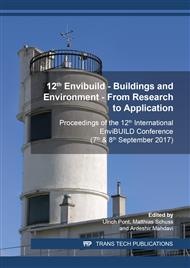[1]
B. Adeney-Risakotta (ed.) Dealing with Diversity – Religion, Globalization, Violence, Gender and Disaster in Indonesia. Globalethics.net Focus. Geneva: Globethics.net / Yogyakarta: Indonesian Consortium for Religious Studies, (2014).
Google Scholar
[2]
S. Elias and C. Noone. The Growth and Development of the Indonesian Economy. In Reserve Bank of Australia – Bulletin, December Quarter 2011. Available online via https://www.rba.gov.au/publications/bulletin/2011/dec/pdf/bu-1211-4.pdf (last checked: Aug 2017).
Google Scholar
[3]
H. Lukas. The perception of Indonesia's history and culture by Western historians and social scientists, in Indonesia's Cultural Diversity in Times of Global Change, A one-day seminar organized by the Indonesian Embassy, Brussels 16th December (2002).
Google Scholar
[4]
L.M. Ross, Mask, Gender, and Performance in Indonesia: An Interview with Didik Nini Thowok. Asian Theatre Journal, vol. 22, no. 2 (Fall 2005). © 2005 by University of Hawai'i Press.
DOI: 10.1353/atj.2005.0033
Google Scholar
[5]
H. Manns and S. Musgrave. On the Internet, no-one knows you're from Suroboyo: Ethnic identity from the digital margins to the mainstream core. Paper 147 of Tilburg Papers in Cultural Studies.
Google Scholar
[6]
Bank Dunia, Department for International Development (ed.) PEACE. 2007. Indonesia and Climate Charge: Current Status and Policies. Available via https://siteresources. worldbank.org/INTINDONESIA/Resources/Environment/ClimateChange_Full_EN.pdf (last checked Aug 2017).
Google Scholar
[7]
T. Boen. Earthquake Resistant Design of Non-Engineered Buildings In Indonesia. Presented at EQTAP Workshop IV, Kamakura Dec 3-4,(2001).
Google Scholar
[8]
B.A. Putra. Earthquake Resistant Structures on the Traditional Houses in Indonesia. Research Journal of Science & IT Management, Volume: 02, Number: 03, January-(2013).
Google Scholar
[9]
P. Gruber, U. Herbig. Research of Environmental Adaptation of traditional Building Constructions and Techniques in Nias; Presentation: CIPA 2005 XX International Symposium, Proceedings, Turin; 26.09.2005 - 01.10.2005; in: CIPA 2005 XX International Symposium, Proceedings", CIPA Heritage Documentation, XX International Symposium (2005), ISSN: 1682-1777; Paper-Nr. 1062, 6 S.
DOI: 10.1111/j.1477-9730.2010.00573.x
Google Scholar
[10]
P. Gruber, U. Herbig: Settlements and Housing on Nias island, Adaptation and Development, in: volume 2,, TRANS URBAN (Hrg.); IVA, Wien, 2006, ISBN: 3-900265-07-0, S. 70 - 87.
Google Scholar
[11]
A. Ardiyanto, A. Djunaedi, Ikaputra, D. A. Suryabrata. Thomas Karsten and the Java Traditional Architecture Development and Innovation. The International Journal Of Humanities & Social Studies (ISSN 2321 - 9203), Vol 3 Issue 7 July, 2015, pp.285-291.
Google Scholar
[12]
I. Mayer, and F. Zámolyi. Kolonialarchitektur in Indonesien; in: Kolonialismus: Architektur - Städtebau - Kultur,, V. Capresi (Ed,.); NWV Neuer Wissenschaftlicher Verlag, Wien - Graz, 2007, ISBN: 978-3-7083-0165-5, pp.153-177.
Google Scholar
[13]
P. Oliver (ed.) Encyclopedia of Vernacular Architecture of the World. Cambride University Press. 1997 ISBN-13: 978-0521564229.
Google Scholar
[14]
L.M. Krebs. Contemporary Vernacular – Traditionelle Bauprinzipien in der indonesischen Architektur des 21. Jahrhunderts. Master Thesis, TU Wien, supervised by E. Lehner. (2016).
Google Scholar
[15]
K. Wammerl. Malam Tropis ein Filmklub in Yogyakarta; Master Thesis, TU Wien, supervised by C. Hohenbüchler. (2017).
Google Scholar
[16]
A. Tanesia. The stories of Affandi. Jakarta : Mahameru Offset Printing, 2012. ISBN 9786021982709.
Google Scholar
[17]
U. Herbig, G. Styhler-Aydin, D. Grandits, L. Stampfer, U. Pont, I. Mayer. Digital workflows for restoration and management of the Museum Affandi – A case study in challenging circumstances in The International Archives of the Photogrammetry, Remote Sensing and Spatial Information Sciences, Volume XLII-2/W5, 2017, 26th International CIPA Symposium 2017, 28 August–01 September 2017, Ottawa, Canada.
DOI: 10.5194/isprs-archives-xlii-2-w5-329-2017
Google Scholar
[18]
D. Grandits, L. Stampfer. Poster/Performance Affandi, Science Slam, Conference on Cultural Heritage and New Technologies, Wiener Rathaus, November (2016).
Google Scholar
[19]
U. Herbig, T. Tezarek, U. Pont, and A. Mahdavi. Back to simple- disruptive methods for the improvement of the building performance of the Museum Affandi"; Vortrag: 4th Biennale ICIAP - International Conference on Indonesian Architecture and Planning, Yogyakarta, Indonesia (invited); 26.07.2018 - 27.07.2018; in: "4th Biennale ICIAP - International Conference on Indonesian Architecture and Planning - Design and Planning in the Disruptive Era,, B. Setiawan, I. IWiendu, A. Sarwadi, I. Ikaputra, S. Roychansyah (ed.); (2018).
DOI: 10.1145/3284389
Google Scholar
[20]
T. Tezarek. Thermal performance analysis of buildings in a hot and humid Climate: The case of the Affandi Museum in Yogyakarta, Indonesia. Master Thesis, TU Wien, supervised by A. Mahdavi, U. Pont. (2018).
Google Scholar
[21]
Webpage Affandi.org; Available via http://www.affandi.org/ (last checked Aug 2017).
Google Scholar
[22]
Journal of Comparative Cultural Studies in Architecture (JCCS-a), Special Issue: Approaches on Transformations of Indonesian Traditional Architecture (2017).
Google Scholar
[23]
C. Allerton. Authentic housing, authentic culture?: transforming a village into a tourist site, in Manggarai, eastern Indonesia [online]. 2003. London: LSE Research Online. Available at: http://eprints.lse.ac.uk/archive/00000967.
DOI: 10.1080/13639810304440
Google Scholar
[24]
J. Lad. Preservation of the Mbaru Niang, Wae Rebo Village, Flores Island, Indonesia (2013 On Site Review Report) available via https://archnet.org/system/publications/contents/8745/ original/DTP101244.pdf?1391602998 (last checked: Aug 2017).
Google Scholar
[25]
U. Herbig (ed./organizers) Programme of the Study Day on Transformation of Traditional Architecture in Indonesia - Tra2in, March 24, 2017, Böcklsaal TU Wien, Karlsplatz 13, 1040 Wien.
Google Scholar
[26]
N. Purwestri and F. Suryaningsih. Constructing an Indonesian Architecture Documentation. in ICAM 17 (International Conferderation of architectural museums conference), Montreal/New York, September 2014, available via http://www.icam-web.org/data/media /cms_binary/original/1486577296.pdf (last checked Aug 2017).
Google Scholar
[27]
Eco-Flores Initiative: http://www.ecoflores.org/ (last checked Aug 2017).
Google Scholar
[28]
ASEA UNINET (ed.) Affandi Museum – A concept of restoration and climate adequate maintenance; Available online via https://asea-uninet.org/portfolio-item/affandi-museum-indonesia/ (last checked: Aug 2017).
Google Scholar


